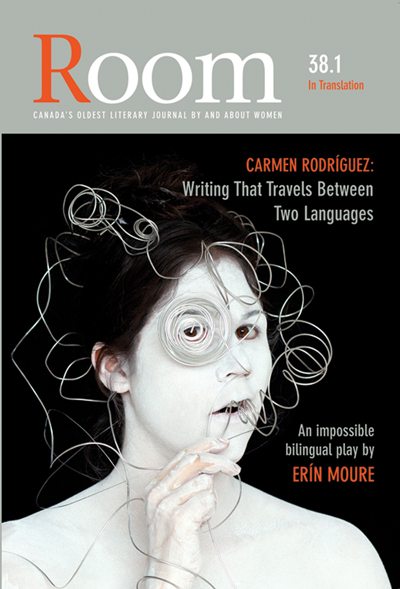In Translation | 38.1
2015
Explore literature translated from languages other than English, and the act of translation in all its senses.
In this issue of Room we explore literature translated from languages other than English, and the act of translation in all its senses.
As a dilettante polyglot, I carry a collection non-English words in my mind—this started in Manitoba schools, where as a teen I learned to swear in Cree, and extends to today when I use one perfect word to say I miss you in Egyptian Arabic. My sophomoric beginnings aside, I think each word I learn that doesn’t exist in my mother tongue provides another way for me to look at things, another angle I hadn’t considered.
In my interview with Carmen Rodríguez—in which we discuss how her writing travels like she has from Chile to Canada—she shares one word in Spanish that means someone you cannot do without. In the opening of the issue, Souvankham Thammavongsa shows us how a Lao connotation opens us up to a new way of understanding the word pregnant. We then close the issue with michele marie desmarais’ exploration of the word “owl,” where she finds relationships between meanings from Michif, Dakota, Sanskrit, and English. Writing such as theirs shows how submerging ourselves into another language can give us a greater understanding of the world. When we try new tongues, our own becomes richer with infusions and transfusions of new elements, and foreign turns of phrase.
But just reading a good translation in English—and we also have some of those in the issue—gives us a lens to look through and understand (if only briefly) how writers from other times and places may think and feel. Because we know the impact literature has on our humanity, we see the potential for reading to dissolve preconceptions or misconceptions we have about another culture. More than ever before, readers understand how crucial it is to expand our repertoires, to find stories and ideas outside of narratives that dominate prescribed reading lists and literary review pages.
In this issue, our “translators,” like Rodríguez, Thammavongsa, and desmarais, are often the original writers. They are immersed so completely that they can express themselves in two (or more) tongues. Take our commissioned writer, Erín Moure, a true polyglot and voluminous translator, who presents an impossible play to illustrate her ideas about language and meaning.
Since contributors to this issue typically began their language immersion in transit (migration, travel, forced exile), it’s also appropriate that translation means moving from one place to another. Najwa Ali describes languages as “becoming tickets and mirrors.” Sneha Madhavan-Reese listens to stories in a language she doesn’t know, filled with words she still understands. Shelley Wood describes her own “clumsy, dismemberment” of language that becomes poetic while travelling in the back seats of taxis.
Finally, it is Meryl McMaster’s series of portraits that illustrate the most direct definition of translation. Each of her subjects, which includes herself on our cover, become sculptural creations, converted from one form to another. This definition is the thread that binds the creative expressions found in the following pages.
I hope you, too, are transformed by the act of reading “In Translation.”
—Rachel Thompson

$10.00 – $21.00
Additional information
| Delivery | Canada, USA, International, Digital |
|---|
In this issue: Najwa Ali, Sarah Bernstein, Sarah Christina Brown, Sandra Widner Burch, michele marie desmarais, Medina Faris, Candace Fertile, Rebecca Fisseha, Amy Goh, Taryn Hubbard, Jane Iordakiyeva, Lan Lan (蓝蓝), Jennifer Lighty, Stephanie L. Lu, Sneha Madhavan-Reese, Meryl McMaster, Emily Milliken, Erín Moure, Doireann Ní Ghríofa, Helen Polychronakos, Rebekah Rempel, Carmen Rodríguez, Meaghan Rondeau, Carrie Schmidt, Souvankham Thammavongsa, Rachel Thompson, Christina Tjandra, Cindy Veach, Kayi Wong, Shelley Wood, Anna Yin